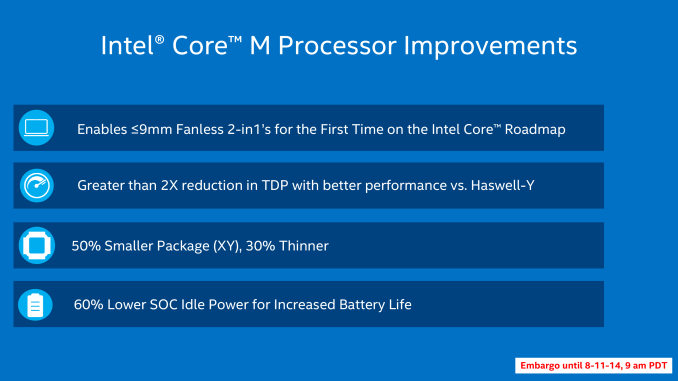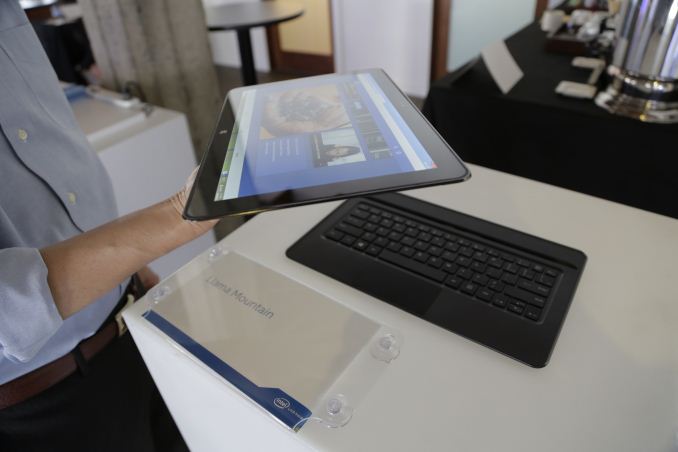Intel Broadwell Architecture Preview: A Glimpse into Core M
by Ryan Smith on August 11, 2014 12:01 PM ESTClosing Thoughts
Wrapping up our preview of the Broadwell architecture and Intel’s Core M processor, the bulk of Intel’s presentation and focus today is on the latter, so that is where we’ll start.
Core M is not a make-or-break product for Intel, but none the less it is a very important one. Mobile devices – be it tablets, slates, transformers, 2-in-1s etc – are continuing to increase in popularity, and as we’ve seen with ARM based tablets so far they form a market that has continued to grow and continued to erode the x86 laptop market that Intel has dominated for so long. Though laptops as a category are not going anywhere any time soon, their erosion means that Intel needs to get into mobile devices if they want to maintain their sales and their stature. To that end it’s not too late for Intel to break into this market and turn things around, but if they’re going to succeed then they need to make their move sooner or later, and this is where Core M fits in.
It’s telling then that while Intel is going after this market with a Core architecture, they are doing so under a different Core brand. Core M doesn’t just represent a new low powered Core CPU, but in Intel’s eyes is another product entirely. One that is so different that it does away with the Core i3/i5/i7 convention entirely and gets its own brand name and own product numbers. Core M is still Core, but it is nearly unrecognizable compared to the Core of even 4 years ago.
As far as the Core M product is concerned then, while Intel’s plans are grand they are not without merit. Backed by Intel’s new 14nm process and the Broadwell architecture, Core M looks like it should finally resolve the issues that dogged even Haswell-Y by bringing down power consumption even further while improving on Intel’s already strong performance, and getting the resulting processor in an SoC small enough to be usable in even the thinnest mobile devices. In fact from a technical perspective there’s little reason to doubt Core M; we’ll still have to wait to see just how good the resulting retail products are, but there shouldn’t be any technical reason for why it can’t be put into a mobile device comparable to today’s 10”+ tablets. Intel’s own Llama Mountain reference design can vouch for that much, showcasing the viability of Core M in a 12.5” tablet that’s just 7.2mm thick.
Intel's Llama Mountain, a Core M form factor reference design
More likely what will determine Core M’s fate and Intel’s ability to completely break into the mobile device market will be pricing. Intel’s profit margins are somewhat legendary in the computer industry, and a big part of that profitability has come from the high prices Intel has enjoyed from products such as their Core processors. Core M, like the other Cores before it, will still be an upscale product – a higher priced, higher performance alternative to Intel’s mass-market Atom processors. And while that makes plenty of sense on paper, in the real world Intel has to face the AllWinners and other ARM vendors of the world who are happy to sell their ARM SoCs at significantly lower margins, which can have a knock-on effect even if they can’t compete with Intel on overall performance. At this point it’s far too early to call this, especially when Intel isn’t even discussing Core M pricing at this time, but it’s a subject that Intel will have to consider carefully as “good enough” ARM devices will continue to be the biggest threat to Intel’s position in the CPU market.
Moving on, while today’s release from Intel only offers us a preview of what Intel will be delivering with their Broadwell architecture, what Intel has presented thus far looks to continue Intel’s tradition of relentless execution. As a tick Broadwell is a small but respectable improvement in Intel’s Core architecture, with the expected 5% IPC improvement in-line with previous ticks. For more traditional desktops and laptops it won’t radically change the world, but then it never was meant to. The biggest question for these parts will be whether Broadwell will improve on Haswell’s clockspeeds at all – a clockspeed boost made possible by Intel’s 14nm process – or if we’re going to hold steady similar to what we saw with the last tick, Ivy Bridge.
Meanwhile Broadwell’s GPU improvements are more significant, and in the race to further improve what’s essentially the baseline for PC GPU performance it is always welcome. Furthermore the fact that Intel is now at API feature parity with discrete GPUs is a big deal for Intel and it is a big deal for iGPUs as a whole. What we still want to see is more performance; a single slice seems just about right for Core M, but if we’re talking about larger laptop and desktop parts it would be very nice to see something akin to GT3 become baseline, especially with the die size savings Intel will be seeing from the 14nm process.
Finally, from here the rest of Intel’s 2014 should be rather busy. Next month is Intel’s Fall IDF 2014, at which point we expect we’ll be given a deeper look at Broadwell’s architecture. Past that the first Broadwell-Y based Core M processors will be on the shelves for the holidays, and with it our chance to see Broadwell and Intel’s 14nm process in action. However that will also be our only chance to see Broadwell in action this year; while Core M will ship in time for the holidays, the rest of the Broadwell lineup will not appear until 2015.













158 Comments
View All Comments
Yesumanu - Monday, August 11, 2014 - link
Not true, assuming Intel will integrate Iris Pro into its mobile CPUs. With HD5200 (iGPU) you can run just about any game on 768p with at least medium settings. Here are some benchmarks for that iGPU: http://www.anandtech.com/show/6993/intel-iris-pro-... I know that TDP there 47W but it includes quad core i7 clocked at 3,6GHz wnich itself draws some power. Intel could improve on that design, put it into its newest CPUs and if they do, they sure will brag about it.Yesumanu - Monday, August 11, 2014 - link
Sorry, I messed up the link. You can erase the dot at the end or use this: http://www.anandtech.com/show/6993/intel-iris-pro-...winterspan - Monday, August 11, 2014 - link
Core M is NOT going to have IRIS ProStevoLincolnite - Monday, August 11, 2014 - link
Half the problem with Intel Decelerators is with the graphics drivers, AMD and nVidia's drivers are gold plated in comparison, sure they are better these days than they used to be, but still hardly ideal.RyuDeshi - Monday, August 11, 2014 - link
In a tablet form factor you are going to encounter severe thermal throttling while gaming, the Anandtech article you linked doesn't have those cooling restraints. Just look at Anantech's article on the Surface Pro 3's thermal throttling. Despite having a slightly better i5, it does worse in most heavy use scenarios.RyuDeshi - Monday, August 11, 2014 - link
Better i5 than the surface pro 2's version I meant to say.mb5625083591 - Monday, August 11, 2014 - link
I think this discussion is completely irrelevant. Very few are going for a graphical gaming tablet (unless it's poker or fruit slices, etc.). That field is dominated by Playstation or XBox on an HDTV.Tablets and convertibles are for Internet Surfing or business documents, the low end for Internet surfing only.
mkozakewich - Thursday, August 14, 2014 - link
No, we use them for gaming, too. If you get a high-end convertible tablet, it's because a regular tablet doesn't do it and you don't need a similarly-sized laptop. This means that you'll either have a proper big gaming rig or you'll be relying on your convertible to game. I'm doing all my gaming on my Surface Pro 1, and I can play most games with my CPU at 700 MHz. (I mean, there are orders of magnitudes of game needs. I'll sometimes switch it to full-throttle when playing a game, when it needs more power.)mb5625083591 - Monday, August 11, 2014 - link
P.S. For the price of an I7 tablet you can buy BOTH an XBox and Playstation, and maybe HDTV also, and play excellent graphical games.kyuu - Tuesday, August 12, 2014 - link
Sure, but there's an obvious difference between gaming on a mobile device and sitting down in front of a TV. So talking about Xboxes and PlayStations is missing the point by a pretty large margin.